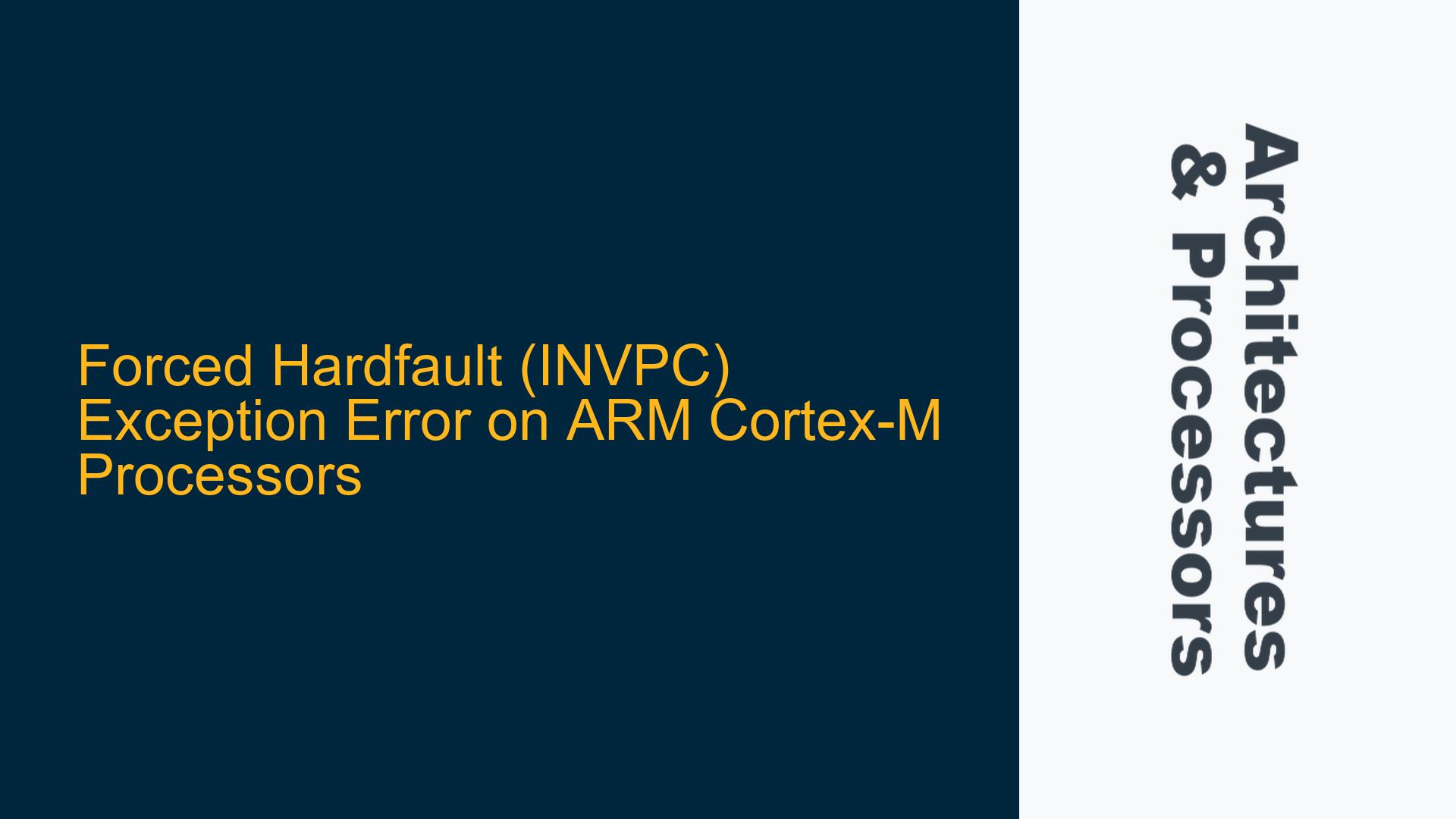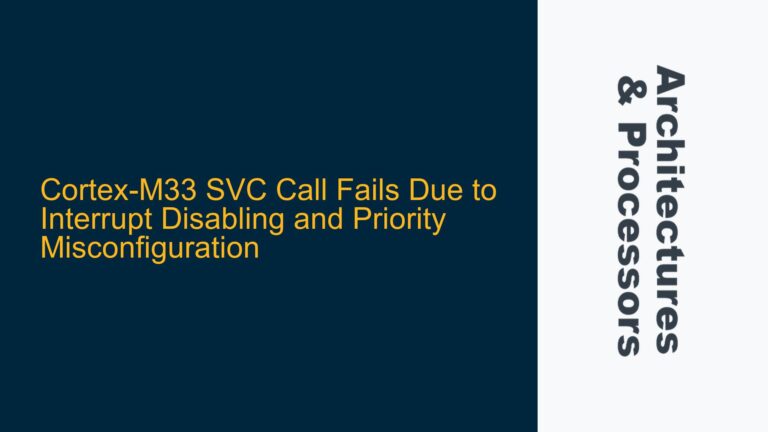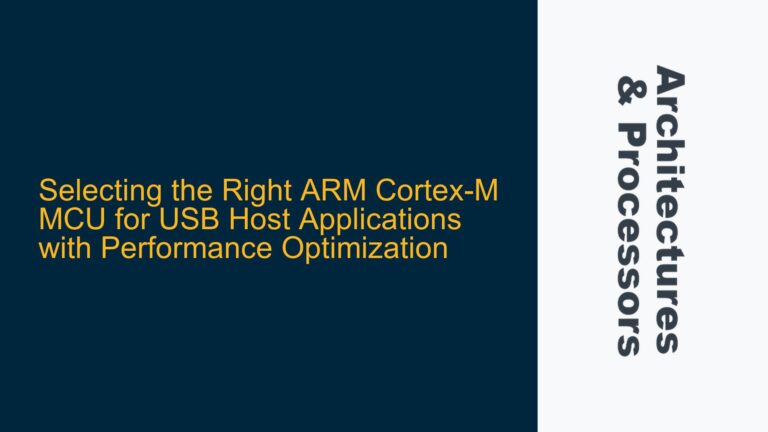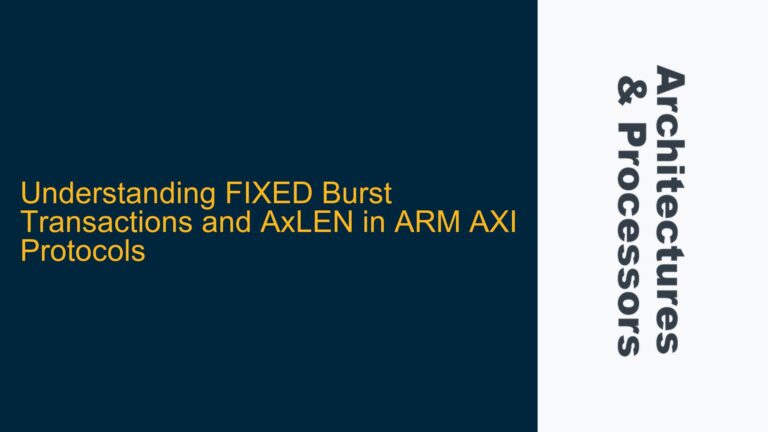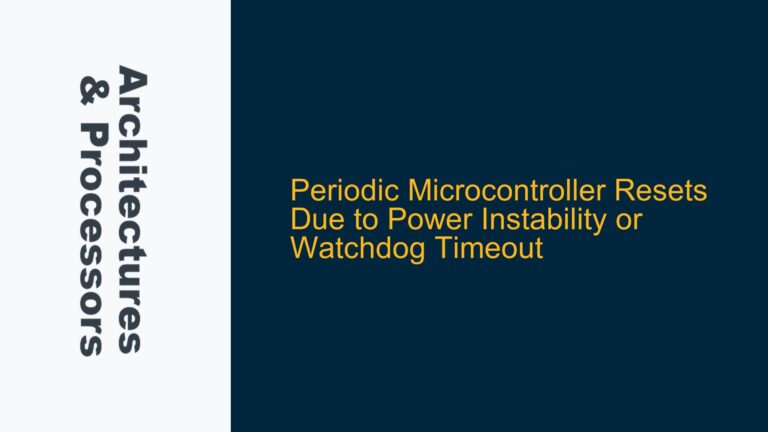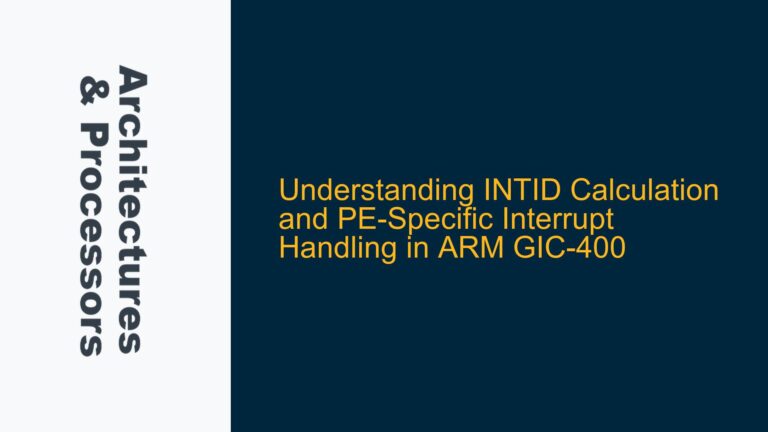ARM Cortex-M INVPC Hardfault: EXC_RETURN Corruption and Stack Issues
The INVPC (Invalid PC Load) hardfault exception is a critical error that occurs on ARM Cortex-M processors when the processor attempts to load an invalid Program Counter (PC) value during exception return. This fault is often triggered by corruption of the EXC_RETURN value, which is a critical part of the exception handling mechanism in ARM Cortex-M architectures. The EXC_RETURN value determines the processor mode and stack pointer (MSP or PSP) to be used upon returning from an exception or interrupt.
The INVPC hardfault is particularly problematic because it indicates a fundamental breakdown in the processor’s ability to resume normal execution after handling an exception. This can lead to system crashes, unpredictable behavior, and data corruption. The fault is often observed in scenarios involving high interrupt loads, such as during network throughput testing with tools like iperf, where frequent interrupts and context switches exacerbate underlying issues.
The fault is typically accompanied by specific register values that provide clues about the root cause. For example, in the reported case, the Hard Fault Status Register (HFSR) shows a value of 0x40000000, indicating a forced hardfault. The xPSR (Program Status Register) value of 0x01000000 suggests that the processor was in Thumb state, and the PRIMASK value of 0x00000001 indicates that interrupts were masked at the time of the fault.
Understanding the INVPC hardfault requires a deep dive into the ARM Cortex-M exception handling mechanism. When an exception occurs, the processor automatically saves key registers (including the PC, xPSR, and others) to the stack. The EXC_RETURN value is then used to restore the processor state upon exception return. If this value is corrupted, the processor may attempt to load an invalid PC, triggering the INVPC hardfault.
Stack Corruption, EXC_RETURN Mismanagement, and Interrupt Handling Errors
The INVPC hardfault is often rooted in one of three primary causes: stack corruption, mismanagement of the EXC_RETURN value, or errors in interrupt handling. Each of these causes can manifest in different ways, but they all ultimately lead to the same result: an invalid PC load during exception return.
Stack Corruption
Stack corruption is one of the most common causes of the INVPC hardfault. The stack is a critical resource in embedded systems, used for storing local variables, function call return addresses, and exception context. If the stack is too small or if a stack overflow occurs, critical data such as the EXC_RETURN value can be overwritten. This is particularly problematic in interrupt-heavy applications, where the stack usage can spike unpredictably.
Stack corruption can also occur due to software bugs, such as buffer overflows or incorrect pointer arithmetic. For example, if a function writes beyond the bounds of a local array, it may overwrite the EXC_RETURN value stored on the stack. Similarly, if a task or thread uses more stack space than allocated, it can corrupt the stack frames of other tasks or the exception handler.
EXC_RETURN Mismanagement
The EXC_RETURN value is a 32-bit value that encodes information about the exception return process. It specifies whether the processor should return to Thread mode or Handler mode, and whether to use the Main Stack Pointer (MSP) or Process Stack Pointer (PSP). If this value is corrupted or incorrectly modified, the processor may attempt to load an invalid PC, triggering the INVPC hardfault.
EXC_RETURN mismanagement can occur due to several reasons. For example, if a context switching routine incorrectly modifies the EXC_RETURN value, it can cause the processor to return to an invalid state. Similarly, if an interrupt handler modifies the stacked xPSR or other registers, it can lead to an incorrect EXC_RETURN value being used during exception return.
Interrupt Handling Errors
Interrupt handling errors are another common cause of the INVPC hardfault. These errors can occur if an interrupt handler does not properly save and restore the processor state, or if it incorrectly modifies the VECTCLRACTIVE bit in the System Control Block (SCB). The VECTCLRACTIVE bit is used to clear the active status of an interrupt, and if it is modified while the interrupt is still running, it can lead to an invalid exception return.
Interrupt handling errors can also occur if the interrupt priority is not properly configured. For example, if a higher-priority interrupt preempts a lower-priority interrupt and modifies the stack or EXC_RETURN value, it can lead to an INVPC hardfault when the lower-priority interrupt attempts to return.
Diagnosing and Resolving INVPC Hardfaults: Stack Analysis, Exception Handling, and Debugging Techniques
Resolving INVPC hardfaults requires a systematic approach to diagnosing and addressing the root cause. The following steps provide a detailed guide to troubleshooting and fixing INVPC hardfaults on ARM Cortex-M processors.
Step 1: Analyze Stack Usage and Configuration
The first step in diagnosing an INVPC hardfault is to analyze the stack usage and configuration. This involves determining whether the stack is large enough to handle the maximum stack usage during normal operation and exception handling. Many development toolchains provide stack usage analysis tools that can help identify potential stack overflows.
If the stack size is insufficient, increasing the stack size may resolve the issue. However, it is also important to identify any software bugs that may be causing stack corruption, such as buffer overflows or incorrect pointer arithmetic. Static code analysis tools can help identify potential issues in the code.
Step 2: Verify Exception Handling and Context Switching Code
The next step is to verify the exception handling and context switching code. This involves ensuring that the EXC_RETURN value is correctly managed and that the processor state is properly saved and restored during exceptions and context switches.
One common issue is the incorrect use of the VECTCLRACTIVE bit in the SCB. This bit should only be modified when it is safe to do so, and care must be taken to ensure that it is not modified while an interrupt is still running. Similarly, the context switching code must ensure that the EXC_RETURN value is not corrupted during the switch.
Step 3: Debugging and Register Analysis
Debugging an INVPC hardfault requires a detailed analysis of the processor registers at the time of the fault. The Hard Fault Status Register (HFSR), Program Status Register (xPSR), and other key registers can provide valuable clues about the root cause of the fault.
For example, the HFSR value of 0x40000000 indicates a forced hardfault, while the xPSR value of 0x01000000 indicates that the processor was in Thumb state. The PRIMASK value of 0x00000001 indicates that interrupts were masked at the time of the fault, which may suggest that the fault occurred during a critical section of code.
Using a debugger, it is possible to set breakpoints and examine the stack and register values at the time of the fault. This can help identify the exact location in the code where the fault occurred and provide insights into the root cause.
Step 4: Implement Data Synchronization Barriers and Cache Management
In some cases, the INVPC hardfault may be caused by cache coherency issues or incorrect memory access timing. Implementing data synchronization barriers (DSB) and cache management techniques can help ensure that the processor state is consistent and that memory accesses are properly synchronized.
For example, if the fault occurs during a DMA transfer or other memory-intensive operation, it may be necessary to invalidate the cache or use memory barriers to ensure that the processor and memory are synchronized.
Step 5: Review and Optimize Interrupt Handling
Finally, it is important to review and optimize the interrupt handling code. This includes ensuring that interrupt priorities are correctly configured and that interrupt handlers do not modify the stack or EXC_RETURN value in a way that could lead to an INVPC hardfault.
If the fault occurs during high interrupt loads, such as during network throughput testing, it may be necessary to optimize the interrupt handling code to reduce the interrupt latency and ensure that the processor can handle the interrupt load without triggering a fault.
By following these steps, it is possible to diagnose and resolve INVPC hardfaults on ARM Cortex-M processors. The key is to systematically analyze the stack, exception handling, and interrupt handling code, and to use debugging tools to identify and address the root cause of the fault. With careful analysis and optimization, it is possible to ensure reliable and robust operation of ARM Cortex-M-based embedded systems.
